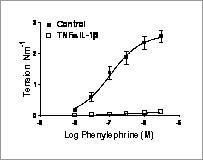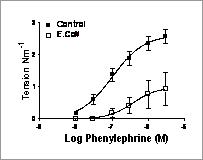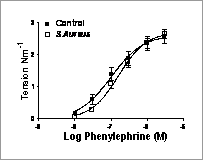Print version
Search Pub Med
Tumor necrosis factor is essential for s.aureus, but not e.coli induced vasoplegia: relevance to toll like receptor signalling and sepsis Sepsis carries a mortality of up to 64% . Sepsis is characterised clinically by hypotension, refaractory to vasopressors, which is attributable to both cardiac depression and vascular hyporesponsiveness. Circulating levels of tumor necrosis factor (TNF) are elevated in both Gram positive and Gram negative sepsis. Clinical trials have shown a benefit of the anti-TNF antibody afelimomab in sepsis, although the benefit was small and evident only in selected patients. However, no analysis of effectiveness in Gram positive versus Gram negative infections was performed, although sensing and signalling for these pathogens differ dramatically. We investigated the role of TNF in the sensing of Gram positive S.aureus versus Gram negative E.coli by blood vessels using genetically modified (TNF knockout, TNF -/-) mice. Aortae were removed from TNF-/- (male, 26-31g) or wild type (male, 28-31g) C57BK/6 mice and cultured for 24h in vitro in DMEM alone (control) or DMEM with S.aureus (108 CFU/ml), E.coli (108 CFU/ml) or TNF a + IL-1β (both 10ng/ml). Cultured aortic rings were mounted on a DMT wire myograph in physiological saline solution at 37 ° C bubbled with 5%CO2, 95%O2 (PSS). Phenylephrine (PE) was added cumulatively (10-8–3x10-6M) and isometric force was measured. Tension was calculated from vessel length. Vessels were washed with PSS and incubated with L-arginine (10-4M; for maximal nitric oxide synthase II activity-results reported in abstract) for 30 minutes before PE induced responses were repeated. All results were analysed using a two-way ANOVA, p<0.05 was considered significant. In wild type mice both E.coli or S.aureus induced hyporesponsiveness to PE (Emax in N/m for control 2.35 ± 0.07, E.coli 1.25 ± 0.20, n=3 p<0.001; control 2.62 ± 0.28, S.aureus 1.80 ± 0.14, n=5 p<0.001) By contrast, in vessels from TNF -/- mice, S.aureus did not effect contractility of vessels to PE (Figure)
Vessels from TNF-/- mice. E. coli or TNF + IL-1β cause hyporesponsiveness to PE (n= 5, p<0.001) but not S.aureus (n=5, p>0.05) TNF plays an essential role in Gram positive bacterial induced vascular dysfunction, and how this differs for Gram negative bacteria. These data suggests that anti-TNF therapies may be more beneficial in Gram positive than in Gram negative sepsis. This should be considered in future trials.
This work was kindly supported by the British Heart Foundation . |




